American crow
| American crow | |
|---|---|
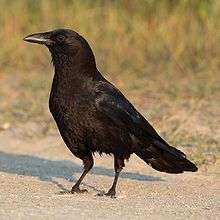 | |
| Scientific classification | |
| Kingdom: | Animalia |
| Phylum: | Chordata |
| Class: | Aves |
| Subclass: | Neornithes |
| Infraclass: | Neognathae |
| Superorder: | Neoaves |
| Order: | Passeriformes |
| Suborder: | Passeri |
| Superfamily: | Corvoidea |
| Family: | Corvidae |
| Genus: | Corvus |
| Species: | C. brachyrhynchos |
| Binomial name | |
| Corvus brachyrhynchos Brehm, 1822 | |
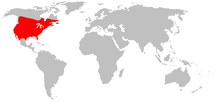 | |
| Global range | |
The American crow (Corvus brachyrhynchos) is a large passerine bird species of the family Corvidae. It is a common bird found throughout much of North America. American crows are the new world counterpart to the carrion crow and the hooded crow. Although the American crow and the hooded crow are very similar in size, structure and behavior, their calls are different. The American crow nevertheless occupies the same role the hooded crow does in Eurasia.
From beak to tail, an American crows measures 40–50 cm (16–20 in), almost half of which is tail. Mass varies from about 300 to 600 g (10 to 20 oz). Males tend to be larger than females. The most usual call is CaaW!-CaaW!-CaaW!.
The American crow is all black, with iridescent feathers. It looks much like other all-black corvids. They can be distinguished from the common raven (C. corax) because American crows are smaller and from the fish crow (C. ossifragus) because American crows do not hunch and fluff their throat feathers when they call.
American crows are common, widespread, and susceptible to the West Nile virus, making them useful as a bioindicator to track the virus's spread. Direct transmission of the virus from American crows to humans is unheard of and unlikely.
Taxonomy
The American crow was described by Christian Ludwig Brehm in 1822.[2] Its scientific name means literally "short-billed crow", from Ancient Greek brachy- (βραχυ-) "short-" and rhynchos (ρυνχος) "billed".[3]
The northwestern crow (C. caurinus) is very closely related to the American crow. Its ancestors became separated by Ice Age glaciation west of the Rocky Mountains. It is endemic to Pacific temperate rain forests where it all but replaces the American crow. Only in the Seattle region do they co-occur to any extent. In form the two species are much alike. There is a marked difference in voice.[4]
Subspecies
Four subspecies are recognized. They differ in bill proportion and form a rough NE-SW clinal in size across North America. Birds are smallest in the far west and on the south coast.[5]
- Corvus brachyrhynchos brachyrhynchos – eastern crow: northeastern United States, eastern Canada and surroundings. Largest subspecies.
- Corvus brachyrhynchos hesperis – western crow: Western North America except arctic north, Pacific Northwest and extreme south. Smaller overall with a proportionally more slender bill[6] and low-pitched voice.
- Corvus brachyrhynchos pascuus – Florida crow: Florida. Mid-sized, short-winged but decidedly long bill and legs.[6]
- Corvus brachyrhynchos paulus – southern crow: southern United States. Smaller overall, bill also small.[7]
Description
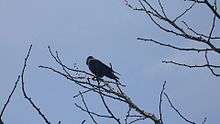
The American crow is a large, distinctive bird with iridescent black feathers all over. Its legs, feet and bill are also black. They measure 40–53 cm (16–21 in) in length, of which the tail makes up about 40%. The wing chord is 24.5 to 33 cm (9.6 to 13.0 in), with the wingspan ranging from 85 to 100 cm (33 to 39 in). The bill length can be from 3 to 5.5 cm (1.2 to 2.2 in), varying strongly according to location. The tarsus is 5.5 to 6.5 cm (2.2 to 2.6 in) and the tail is 13.5 to 19 cm (5.3 to 7.5 in).[5] The body mass can vary from 316 to 620 g (11.1 to 21.9 oz). Males tend to be larger than females.[8][9]
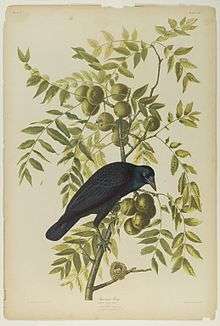
The most usual call is a loud, short, and rapid caaw-caaw-caaw. Usually, the birds thrust their heads up and down as they utter this call. American crows can also produce a wide variety of sounds and sometimes mimic noises made by other animals, including other birds.
Visual differentiation from the fish crow (C. ossifragus) is extremely difficult and often inaccurate. Nonetheless, differences apart from size do exist. Fish crows tend to have more slender bills and feet. There may also be a small sharp hook at the end of the upper bill. Fish crows also appear as if they have shorter legs when walking. More dramatically, when calling, fish crows tend to hunch and fluff their throat feathers.
If seen flying at a distance from where size estimates are unreliable, the distinctly larger common ravens (C. corax) can be distinguished by their almost lozenge-shaped tail and their larger-looking heads. They also fluff their throat feathers when calling like fish crows, only more so.
The average life span of the American crow in the wild is 7–8 years. Captive birds are known to have lived up to 30 years.[10]
Distribution and habitat
The range of the American crow now extends from the Pacific Ocean to the Atlantic Ocean in Canada, on the French islands of Saint-Pierre and Miquelon, south through the United States, and into northern Mexico.[1] The increase in trees throughout the Great Plains during the past century due to fire suppression and tree planting facilitated range expansions of the American crow[11] as well as range expansions of many other species of birds.[12][13][14] Virtually all types of country from wilderness, farmland, parks, open woodland to towns and major cities are inhabited; it is absent only from Pacific temperate rain forests and tundra habitat where it is replaced by the raven. This crow is a permanent resident in most of the USA, but most Canadian birds migrate some distances southward in winter. Outside of the nesting season these birds often gather in large (thousands or even millions[15]) communal roosts at night.
The American crow was recorded in Bermuda from 1876 onwards.[16]
Behavior
Diet
The American crow is omnivorous. It will feed on invertebrates of all types, carrion, scraps of human food, seeds, eggs and nestlings, stranded fish on the shore and various grains. American crows are active hunters and will prey on mice, frogs, and other small animals. In winter and autumn, the diet of American crows is more dependent on nuts and acorns. Occasionally, they will visit bird feeders.[17] The American crow is one of only a few species of bird that has been observed modifying and using tools to obtain food.[18]
Like most crows, they will scavenge at landfills, scattering garbage in the process. Where available, corn, wheat and other crops are a favorite food. These habits have historically caused the American crow to be considered a nuisance. However, it is suspected that the harm to crops is offset by the service the American crow provides by eating insect pests.[17]
Reproduction
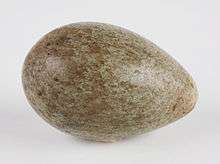
American crows are socially monogamous cooperative breeding birds. Mated pairs form large families of up to 15 individuals from several breeding seasons that remain together for many years.[19] Offspring from a previous nesting season will usually remain with the family to assist in rearing new nestlings. American crows do not reach breeding age for at least two years.[20] Most do not leave the nest to breed for four to five years.[19]
The nesting season starts early, with some birds incubating eggs by early April.[21] American crows build bulky stick nests, nearly always in trees but sometimes also in large bushes and, very rarely, on the ground. They will nest in a wide variety of trees, including large conifers, although oaks are most often used. Three to six eggs are laid and incubated for 18 days. The young are usually fledged by about 36 days after hatching. Predation primarily occurs at the nest site and eggs and nestlings are frequently eaten by snakes, raccoons, ravens and domestic cats. Adults are less frequently predated but face potential attack from great horned owls, red-tailed hawks, peregrine falcons and eagles. They may be attacked by predators such as coyotes or bobcats at carrion when incautious although this is even rarer.[17][22]
West Nile virus
American crows succumb easily to West Nile virus infection. This was originally a mosquito-borne African virus causing encephalitis in humans and livestock since about 1000 AD, and was accidentally introduced to North America in 1999, apparently by an infected air traveller who got bitten by a mosquito after arrival. It is estimated that the American crow population has dropped by up to 45% since 1999.[23] Despite this decline, the crow is considered a species of least concern.[24] The disease runs most rampant in the subtropical conditions which encourage reproduction of its mosquito vectors among which Culex tarsalis is most significant. Mortality rates appear to be higher than those in other birds, causing local population losses of up to 72% in a single season.[20][25] Because of this, American crows are a sentinel species indicating the presence of West Nile virus in an area. Crows cannot transmit the virus to humans directly.[10]
Status and conservation
Crows have been killed in large numbers by humans, both for recreation and as part of organized campaigns of extermination.[26]
American crows are protected internationally by the Migratory Bird Treaty Act of 1918. Despite attempts by humans in some areas to drive away or eliminate these birds, they remain widespread and very common. The number of individual American crows is estimated by BirdLife International to be around 31,000,000. The large population, as well as its vast range, are the reasons why the American crow is considered to be of least concern, meaning that the species is not threatened.[1]
References
- 1 2 3 BirdLife International (2012). "Corvus brachyrhynchos". IUCN Red List of Threatened Species. Version 2013.2. International Union for Conservation of Nature. Retrieved 26 November 2013.
- ↑ Corvus brachyrhynchos. Wikispecies
- ↑ Liddell, Henry George; Scott, Robert; Stuart-Jones, Henry and McKenzie, Roderick: (1980): A Greek-English Lexicon (abridged ed.). Oxford University Press, Oxford, UK. ISBN 0-19-910207-4.
- ↑ Dick, Gary Owen (2007): American Crow. Whatbird.com – Field Guide to Birds of North America. identify.whatbird.com/obj/103/_/American_Crow.aspx Retrieved 2007-October-18.
- 1 2 Madge, Steve & Burn, Hilary (1994): Crows and jays: a guide to the crows, jays and magpies of the world. A&C Black, London. ISBN 0-7136-3999-7.
- 1 2 Goodwin & Gillmor (1976): p. 87
- ↑ Goodwin & Gillmor (1976) p. 88.
- ↑ Kilham, Lawrence. The American Crow and the Common Raven. p. 52
- ↑ American Crow, Life History, All About Birds – Cornell Lab of Ornithology. Allaboutbirds.org. Retrieved on 2013-03-06.
- 1 2 Connecticut Department of Environmental Protection (2001): American Crow Fact Sheet Archived November 5, 2006, at the Wayback Machine.. Version of 2001. Retrieved 2006-October-25.
- ↑ Houston S. 1977. Changing patterns of Corvidae on the prairies. Blue Jay 35:149–155.
- ↑ Livezey KB. 2009a. Range expansion of Barred Owls, part I: chronology and distribution. American Midland Naturalist 161:49–56.
- ↑ Livezey KB. 2009b. Range expansion of Barred Owls, part 2: facilitating ecological changes. American Midland Naturalist 161:323–349.
- ↑ Livezey KB. 2010. Killing barred owls to help spotted owls II: implications for many other range-expanding species. Northwestern Naturalist 91:251–270.
- ↑ Di Dilvestro, Roger. "Something To Crow About". National Wildlife Federation.
- ↑ Long, John L. (1981). Introduced Birds of the World: The worldwide history, distribution and influence of birds introduced to new environments. Terrey Hills, Sydney: Reed. p. 354. ISBN 0-589-50260-3.
- 1 2 3 C. Parr (2005). "Corvus brachyrhynchos". Animal Diversity Web. Retrieved 13 September 2015.
- ↑ Caffrey, Carolee (2000). "Tool Modification and Use by an American Crow". Wilson Bull. 112 (2): 283–284. doi:10.1676/0043-5643(2000)112[0283:TMAUBA]2.0.CO;2.
- 1 2 Roger Segelken: Tree-climbing researcher knows exactly how far the crow flies Archived September 16, 2006, at the Wayback Machine. Cornell Chronicle. Retrieved 2006-October-25,
- 1 2 Cornell Lab of Ornithology (2002): Bird Guide – American Crow. Retrieved 2006-October-24.
- ↑ Henninger, W.F. (1906). "A preliminary list of the birds of Seneca County, Ohio" (PDF). Wilson Bulletin. 18 (2): 47–60.
- ↑ Johnson, Ron American Crows. Internet Center for Wildlife Damage Management
- ↑ LaDeau, Shannon L.; Kilpatrick, A. Marm; Marra, Peter P. (2007). "West Nile virus emergence and large-scale declines of North American bird populations". Nature. 447 (7145): 710–713. doi:10.1038/nature05829. PMID 17507930.
- ↑ Deen, David (December 12, 2012). "The crow – a sociable bird with a long memory". The Chronicle. Barton, Vermont. p. 34.
- ↑ Caffrey, Carolee; Smith, Shauna C.R.; Weston, Tiffany J. (2005). "West Nile Virus Devastates an American Crow Population". Condor. 107 (1): 128–132. doi:10.1650/7646.
- ↑ Campbell, Robert Wayne & Canadian Wildlife Service (1997). "American Crow". The Birds of British Columbia: Passerines : flycatchers through vireos. UBC Press. p. 227. ISBN 978-0-7748-0572-8.
Bibliography
- Goodwin, Derek & Gillmor, Robert (1976): Crows of the World (1st ed.). University of Washington Press, Seattle.
External links
| Wikimedia Commons has media related to Corvus brachyrhynchos. |
| Wikispecies has information related to: Corvus brachyrhynchos |
- Skull of American Crow
- Pictures of American Crow on Birds of the World at Flickr
- "American Crow media". Internet Bird Collection.
- American crow at the Encyclopedia of Life

- American Crow call
- American Crow photo gallery at VIREO (Drexel University)
- The American Crow, Naturally (free e-book)
